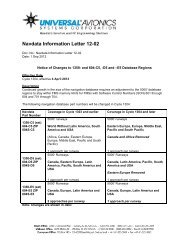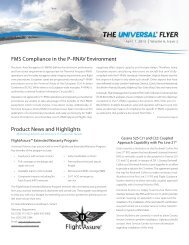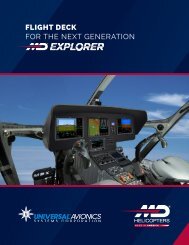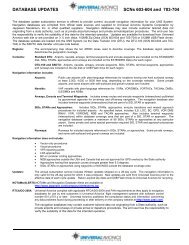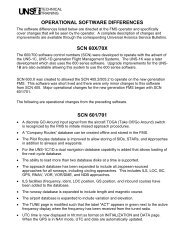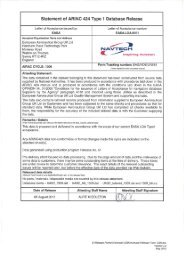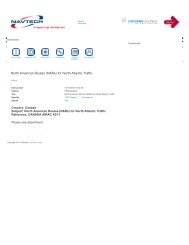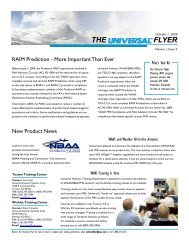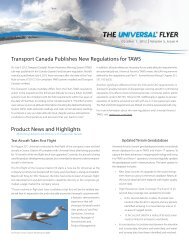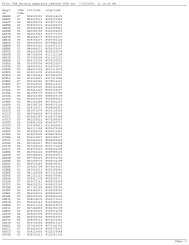Waypoint Naming Conventions
Waypoint Naming Conventions
Waypoint Naming Conventions
Create successful ePaper yourself
Turn your PDF publications into a flip-book with our unique Google optimized e-Paper software.
<strong>Waypoint</strong> <strong>Naming</strong> <strong>Conventions</strong><br />
ARINC Specification 424 provides waypoint naming conventions used in the database. Listed<br />
below are examples of the most common ones that might be encountered when accessing the<br />
Navigation Database.<br />
D235H DME waypoint on radial 235°at 8 nm (H is 8 TH letter)<br />
XYZ29 Point identified by “X” on enroute chart, 29 nm from the XYZ VOR (distances less than<br />
100 nm)<br />
12ABC Point identified by “X” on enroute chart, 112 nm from the ABC VOR (distances greater<br />
than 100 nm)<br />
FF26 FAF for Runway 26<br />
OM26 Outer Marker for Runway 26<br />
MM26 Middle Marker for Runway 26<br />
CF26 FACF for Runway 26 (usually located on final approach course 2-5 nm outside of FAF)<br />
RW26 Threshold coordinates for Runway 26<br />
MA26 Missed Approach Point (MAP) for Runway 26<br />
R-345 DME Arc Terminator on radial 345°<br />
Example Latitude/Longitude Named <strong>Waypoint</strong>s (Oceanic):<br />
ARINC 424 Format FMS Lat/Long Format<br />
5275N<br />
52N075W<br />
75N70<br />
75N170W<br />
5020E<br />
50N020E<br />
50E20<br />
50N120E<br />
5275W<br />
52S075W<br />
52W20<br />
52S120W<br />
6030S<br />
60S030E<br />
60S30<br />
60S130E<br />
Oceanic waypoints (OWPTs) are used for aircraft position reporting upon entry to and exit from<br />
oceanic control areas. In the Navigation Database, these waypoints have a five character<br />
identifier consisting of the latitude and longitude of the waypoint. The FMS converts this five<br />
character identifier to a seven character identifier for screens allowing the display of seven<br />
characters or more. For fields that allow less than seven character identifiers, the five character<br />
identifier is displayed. When manually entering a waypoint identifier, the FMS accepts either the<br />
five or seven character OWPT identifier.<br />
For example, an oceanic waypoint with coordinates of 52:00:00 North Latitude, 75:00:00 West<br />
Longitude has the five letter identifier 5275N in the Navigation Database. When the FMS converts<br />
it to a seven letter identifier, it is displayed as 52N075W.<br />
NOTE: The Navigation Database contains mileage breaks or turning points (unnamed<br />
intersections) which are identified on enroute charts only by an “X”. To interrogate a mileage<br />
break up to and including 99 DME from the associated navaid, enter the navaid identifier, then<br />
the DME distance to the point. For example, if the mileage break were 54 DME<br />
from PDX, then the proper entry would be PDX54. To interrogate a mileage break 100 DME or<br />
farther from the associated navaid, enter the last two digits followed immediately by the navaid<br />
identifier. For example, if the mileage break were 110 DME from FST, then the proper entry<br />
would be 10FST.<br />
The following are examples of different enroute, terminal and approach waypoint naming<br />
conventions:
• R-123 - DME ARC terminator on 123° radial<br />
• TUS – Typically a navaid, e.g., the TUS VOR (or NDB)<br />
• BASER - A pronounceable 5-letter intersection name<br />
• TUS45 - A 45 DME fix from the TUS VOR<br />
• 21TRM - A 121 DME fix from the TRM VOR<br />
• MA123 - The MAP for a circling procedure, lying on the 123 degree radial from (or bearing to)<br />
the referenced navaid.



